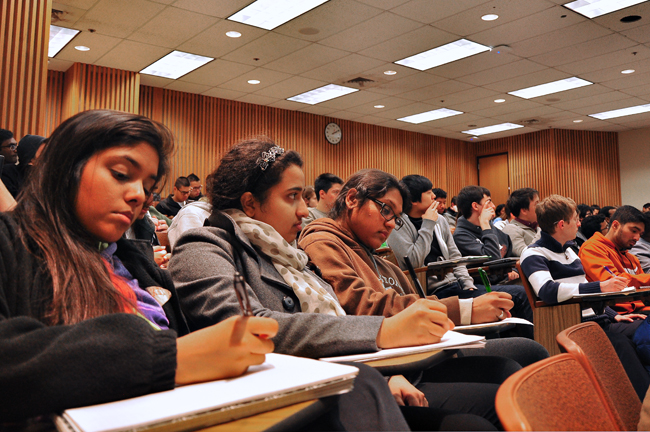As the Cockrell School of Engineering aims to achieve gender balance in its classrooms, some engineering women still feel outnumbered.
According to statistics from the Women in Engineering Program, or WEP, the gap is largest in the electrical, aerospace and mechanical engineering departments, where, this fall, 15.0, 15.4 and 18.8 percent of undergraduate students are women, respectively.
“Those departments are really focused on trying to improve that gap because, if I look at biomedical engineering, it’s over 40 percent women, but mechanical and electrical are under 20 percent,” Cockrell School dean Sharon Wood said. “So, if your two biggest departments are the ones with the smallest ratios, that’s where the efforts are being concentrated.”
While there is a large number of women in biomedical engineering senior Samantha Collins’ biomedical engineering courses — where 44.9 percent of undergraduate enrollees are female — courses she has taken in electrical engineering have been male-dominated.
“There were definitely some girls in there, but it wasn’t as well-distributed as the BME classes,” Collins said.
Civil engineering senior Kirstin Rose said she was one of two girls in a mechanical engineering design course she took her freshman year. She said her civil engineering courses tend to be more gender balanced, but there are still more male students.
According to WEP, 38.3 percent of the undergraduate civil engineering students are women.
To combat the gender imbalances in mechanical engineering, the Cockrell School began an initiative in January to increase the number of women entering the program to 35 percent in five years.
WEP has also developed programs such as “Introduce a Girl to Engineering Day,” which gives young girls the opportunity to come to the UT campus to meet professors and learn about engineering.
WEP director Tricia Berry said the program has also designed initiatives to reach out to female high school students admitted into the engineering college.
“At the Cockrell-school level we also phone call, email and meet female prospective students and admitted students all in an effort to recruit them to come,” Berry said in an email.
According to Berry, since WEP started in 1992, the percentage of women in the Cockrell School has grown from 16 to 25 percent.
“[The growth] is from the fact that there has been these outreach activities over a long period of time — over 15 years of trying to get kids excited and thinking of engineering as an opportunity,” Wood said.
Wood said the growth in the number of women studying engineering could also be attributed to the most recent financial crisis, since most people who get out of college today don’t want to worry about finding a good job along with a burdening debt.
“Engineering gives that stability in jobs, and plus there was all that press about how many more engineers we’re going to need as we move forward,” Wood said.





















